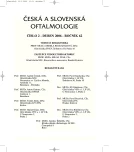The Ultrasound Findings in Posttraumatic Endophthalmitis
Ultrazvukové nálezy u poúrazových endoftalmitid
Cílem práce bylo zhodnotit ultrazvukové nálezy očí s endoftalmitidou po pronikajícím poranění a stanovit prognosticky nepříznivé ultrazvukové známky tohoto závažného onemocnění.
V retrospektivní studii jsme hodnotili nálezy u 7 očí 7 pacientů, kteří byli sledováni na Oční klinice FN Olomouc v období od září 1999 do prosince 2004 pro posttraumatickou endoftalmitidu. Průměrný věk pacientů byl 37,3 roků (22–49). Průměrná doba mezi úrazovým dějem a vznikem endoftalmitidy byla 8,4 dne (1–21). Vstupní vizus byl u všech pacientů velmi nízký, pohyboval se od světlocitu po 1/60. Všichni pacienti podstoupili diagnosticko-terapeutickou pars plana vitrektomii s odběrem sklivce k mikrobiologickému vyšetření a s aplikací antibiotika intravitreálně. Výsledný vizus se pohyboval od 1/60 po 6/12, byla tedy velmi variabilní a bylo možné sledovat souvislost výsledné CZO s tíží penetrujícího poranění a také s prodlevou mezi vznikem endoftalmitidy a začátkem její léčby. Při ultrazvukovém vyšetření jsme se zaměřili na přítomnost membrán ve sklivci, ablace zadní plochy sklivce, ztluštění choroidey, ablace choroidey a odchlípení sítnice.
Membrány ve sklivci mělo 5 očí. Bez sonograficky prokazatelných membrán ve sklivci byly 2 oči, obě měly výslednou CZO lepší než 6/36. Ablaci zadní plochy sklivce jsme prokázali u 3 očí, zadní plocha sklivce nebyla abladována u 4 očí. Nenašli jsme souvislost mezi výslednou CZO a ablací zadní plochy sklivce. Ztluštění choroidey jsme prokázali sonograficky u všech 7 očí. Ablace choroidey nebyla u žádného z očí. Sítnice byla amována u dvou očí.
Pouze 3 oči měly výslednou centrální zrakovou ostrost lepší než 6/36. Cizí nitrooční tělísko jsme nalezli u dvou z těchto očí a u obou byla kultivací prokázána přítomnost bakterie Staphylococcus epidermidis. Třetí oko bylo bez nálezu CNT a kultivací se potvrdily půdní bakterie Enterococcus a Klebsiela. Ultrazvukový nález těchto tří očí se shoduje pouze v nálezu ztluštění choroidey, ostatně jako u všech ostatních očí. U dvou z těchto očí nebyly sonograficky prokázány membrány ve sklivci a nebyla nalezena ani ablace zadní plochy sklivce. Ultrazvukové vyšetření u endoftalmitidy po pronikajícím poranění oka má svá specifika, která souvisí s úrazovým dějem a na rozdíl od pooperační endoftalmitidy nelze přesně stanovit prognosticky nepříznivé známky echografie.
Klíčová slova:
ultrazvuk, endoftalmitida
Authors:
K. Marešová; J. Kalitová; J. Šimičák; J. Řehák
Authors‘ workplace:
Oční klinika LF UP a FN, Olomouc
přednosta doc. MUDr. Jiří Řehák, CSc.
Published in:
Čes. a slov. Oftal., 62, 2006, No. 2, p. 125-132
Overview
The aim of this study was to evaluate the ultrasound findings in eyes with endophthalmitis following penetrating injury and to establish unfavorable predictive signs of this serious disease. In a retrospective study we evaluated findings in 7 eyes of 7 patients followed up because of posttraumatic endophthalmitis at the Department of Ophthalmology, School of Medicine, in Olomouc, Czech Republic, EU, during the period September 1999 – December 2004. The mean age of the patients was 37.3 years (range 22-49 years). The mean duration of the period between the injury and the formation of the endophthalmitis was 8.4 days (range 1 – 21 days). The visual acuity at the time of admittance was very low; it ranged between light perception and 1/60 (0,016 or 20/1200). All patients underwent diagnostic-therapeutic pars plana vitrectomy with vitreous samples taken for microbiological examination and intravitreal antibiotic application. The final visual acuity (VA) ranged from 1/60 (0,016 or 20/1200) to 6/12 (0.5 or 20/40), so it was very variable and that gave us the possibility to follow the connection between the final VA and seriousness of the penetrating injury, and also with the interval between the emergence of the endophthalmitis and beginning of its treatment. During the ultrasound examination, the presence of membranes in the vitreous body, posterior vitreous detachment, thickening of the choroid, detachment of the choroid and detachment of the retina were of concern to us. Membranes were present in the vitreous in 5 eyes. Without membranes detected by the ultrasound, there were 2 eyes; in both of them the final VA was better than 6/36 (0,1667 or 20/120). The posterior vitreous detachment was detected in 3 eyes, and not detected in four eyes.We didn’t find any connection between the final VA and posterior vitreous detachment. The thickening of the choroid was present at the ultrasound examination in all seven eyes. The detachment of the choroid was not found in any eye. The retina was detached in two eyes. In three eyes only, the final central VA was better than 6/36 (0.1667 or 20/120). In two of them, the intraocular foreign body was found and in both the bacteria Staphylococcus epidermidis was detected. In the third eye, the soil bacteria Enterococcus and Klebsiela were cultivated. The ultrasound findings in these three eyes are identical only in the term of thickening of the choroid, similar to other eyes. In two of them no membranes were detected by ultrasound and no posterior vitreous detachment was found. The ultrasound examination in eyes with endophthalmitis after penetrating injury is specific in particular because of the mechanism of the injury. In contrast to the cases of the postoperative endophthalmitis, no prognostic unfavorable sings in the ultrasound examination can be strictly identified.
Key words:
ultrasound, endophthalmitis
Labels
OphthalmologyArticle was published in
Czech and Slovak Ophthalmology

2006 Issue 2
Most read in this issue
- Vernal Keratoconjunctivitis and Possibilities its Treatment
- The Orbital Implant after Exenteration of the Orbit with the Preservation of the Eyelids and the Conjunctival Sac
- The Influence of IOL Implantation on Visual Acuity, Contrast Sensitivity and Colour Vision 2 and 4 Months after Cataract Surgery
- Bilateral Retinal Vasculitis with Arterial Aneurysms
